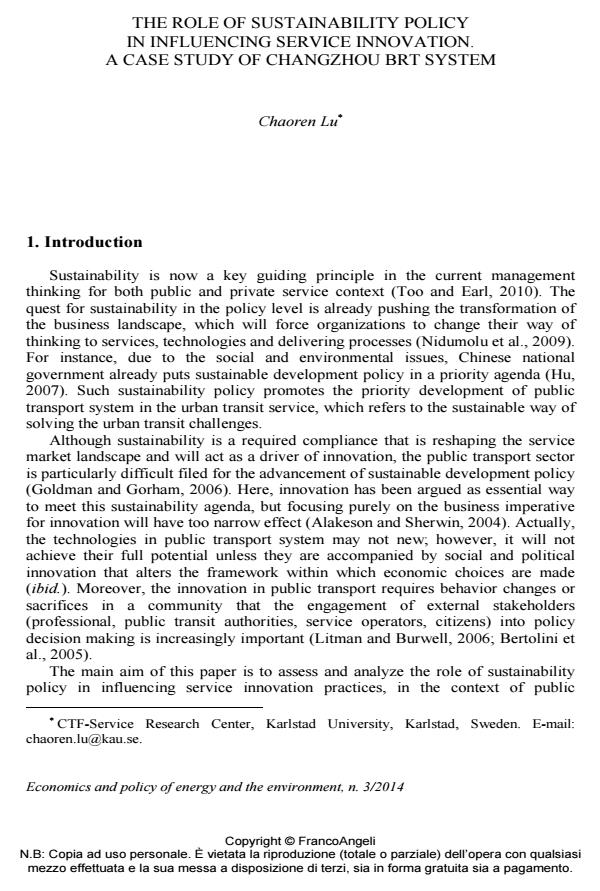The role of sustainability policy in influencing service innovation. a case study of Changzhou BRT system
Titolo Rivista ECONOMICS AND POLICY OF ENERGY AND THE ENVIRONMENT
Autori/Curatori Chaoren Lu
Anno di pubblicazione 2015 Fascicolo 2014/3 Lingua Inglese
Numero pagine 12 P. 167-168 Dimensione file 681 KB
DOI 10.3280/EFE2014-003009
Il DOI è il codice a barre della proprietà intellettuale: per saperne di più
clicca qui
Qui sotto puoi vedere in anteprima la prima pagina di questo articolo.
Se questo articolo ti interessa, lo puoi acquistare (e scaricare in formato pdf) seguendo le facili indicazioni per acquistare il download credit. Acquista Download Credits per scaricare questo Articolo in formato PDF

FrancoAngeli è membro della Publishers International Linking Association, Inc (PILA)associazione indipendente e non profit per facilitare (attraverso i servizi tecnologici implementati da CrossRef.org) l’accesso degli studiosi ai contenuti digitali nelle pubblicazioni professionali e scientifiche
Purpose. The main aim of this paper is to assess and analyze the role of sustainability policy in influencing service innovation practices in the context of public transport. The intension is to understand the critical dimensions related to sustainability policy driven service innovation. The critical dimensions mainly focus on the relationship between innovation and policy, the challenges, competences and opportunities driven by sustainability policy. Design/methodology/approach. The paper is of an explorative nature. Critical case study method is adopted in this paper to understand the role of sustainability policy in service innovation. Findings. The study reveals that national sustainability policy framework drives the formulation and implementation of sustainable service innovation as a tool to achieve sustainable public transit system. The sustainability policy context in terms of responsibility, power and resource integration creates shared-platform that induces service innovation, which create value co-creation opportunities to the customers and other stakeholders. Research limitations/implications. The single case-study design of the present research does not enable empirical generalizations to be made. Contribution/value. The paper makes an original contribution to the study of sustainable and innovative public transit by explicitly linking the adoption of sustainability policy and its role in service innovation and value co-creation embedded on social and environmental perspectives. Practical implications. National policies often cannot influence local/urban transport directly, but become effective tool towards service innovation and value co-creation.
Keywords:Sustainable public transit, sustainability policy, service innovation, value cocreation, bus rapid transit
Jel codes:L88
- Alakeson V. and Sherwin C. (2004). Innovation for sustainable development. London: Forum for the Future.
- Bertolini L., Le Clercq F. and Kapoen L. (2005). Sustainable accessibility: a conceptual framework to integrate transport and land use plan-making. Two test-applications in the Netherlands and a reflection on the way forward. Transport Policy, 12: 207-220. DOI: 10.1016/j.tranpol.2005.01.006
- Corbett J. (1993). San Diego gets a grip on gridlock: City ordinance helps region manage growth.
- Edvardsson B. and Enquist B. (2011). Values-based service for sustainable business: lessons from IKEA. London-New York: Routledge.
- Edvardsson Bo E.B. (2009). Values-based Service for Sustainable Business: Lessons from IKEA. London-New York: Routledge Taylor & Francis Group.
- Goldman T. and Gorham R. (2006). Sustainable urban transport: Four innovative directions. Technology in Society, 28: 261-273. DOI: 10.1016/j.techsoc.2005.10.007
- Haixiao P. (2013). Implementing Sustainable Urban Travel Policies in China. Transport and Sustainability, 3: 43-76.
- Hart S.L. (2007). Capitalism at the Crossoads: Aligning Business, Earth, and Humanity. Upper Saddle River, NJ: Pearson-Prentice Hall.
- Hu J.T. (2007). Hold High the Great Banner of Socialism with Chinese Characteristics and Strive for New Victories in Building a Moderately Prosperous Society in all Respects. The People’s Publishing House.
- Kennedy C., Miller E., Shalaby A., Maclean H. and Coleman J. (2005). The four pillars of sustainable urban transportation. Transport Reviews, 25: 393-414. DOI: 10.1080/01441640500115835
- Litman T. and Burwell D. (2006). Issues in sustainable transportation. International Journal of Global Environmental Issues, 6: 331-347. DOI: 10.1504/ijgenvi.2006.010889
- Michel S., Brown S.W. and Gallan A.S. (2007). An expanded and strategic view of discontinuous innovations: deploying a service-dominant logic. Journal of the Academy of Marketing Science, 36: 54-66. DOI: 10.1007/s11747-007-0066-9
- Nidumolu R., Prahalad C.K. and Rangaswami M.R. (2009). Why sustainability is now the key driver of innovation. Harvard Business Review, 87: 56-64.
- Normann R. and Ramirez R. (1998). Designing interactive strategy: From value chain to value constellation. Chichester: John Wiley and Sons.
- Ongkittikul S. and Geerlings H. (2006). Opportunities for innovation in public transport: Effects of regulatory reforms on innovative capabilities. Transport Policy, 13: 283-293. DOI: 10.1016/j.tranpol.2005.12.003
- Pinkse J., Bohnsack R. and Kolk A. (2013). The Role of Public and Private Protection in Disruptive Innovation: The Automotive Industry and the Emergence of Low-Emission Vehicles. Journal of Product Innovation Management, 31: 43-60. DOI: 10.1111/jpim.12079
- Saarijärvi H., Kannan P.K. and Kuusela H. (2013). Value co-creation: theoretical approaches and practical implications. European Business Review, 25: 6-19. DOI: 10.1108/09555341311287718
- Sohail M., Maunder D.A.C. and Cavill S. (2006). Effective regulation for sustainable public transport in developing countries. Transport Policy, 13: 177-190.
- 10.1016/j.tranpol.2005.11.004. Too L. and Earl G. (2010). Public transport service quality and sustainable development: a community stakeholder perspective. Sustainable Development, 18: 51-61. DOI: 10.1002/sd.412
- Vargo S.L. and Lusch R.F. (2008). Service-dominant logic: continuing the evolution. Journal of the Academy of Marketing Science, 36: 1-10. DOI: 10.1007/s11747-007-0069-6
- Wced (1987). Our common future. World Commission on Environment and Development. Oxford University Press.
- Assessing the impact of transition from nonrenewable to renewable energy consumption on economic growth-environmental nexus from developing Asian economies Muhammad Mohsin, Hafiz Waqas Kamran, Muhammad Atif Nawaz, Muhammed Sajjad Hussain, Abdul Samad Dahri, in Journal of Environmental Management 111999/2021 pp.111999
DOI: 10.1016/j.jenvman.2021.111999
Chaoren Lu, The role of sustainability policy in influencing service innovation. a case study of Changzhou BRT system in "ECONOMICS AND POLICY OF ENERGY AND THE ENVIRONMENT" 3/2014, pp 167-168, DOI: 10.3280/EFE2014-003009